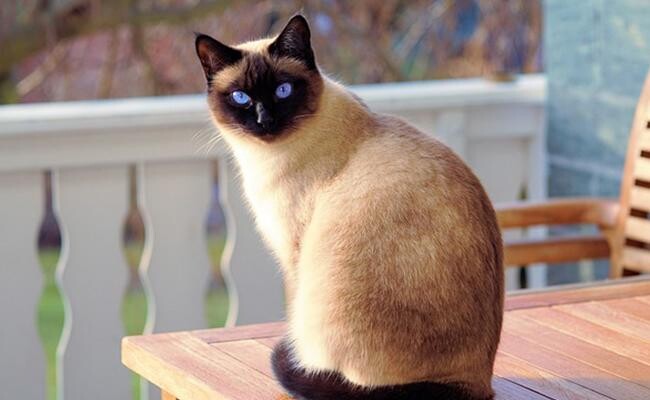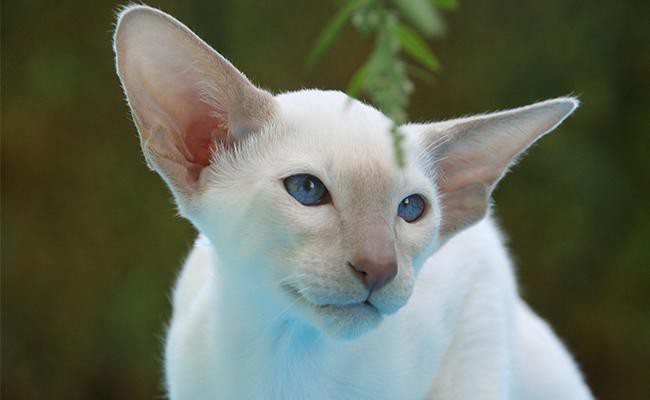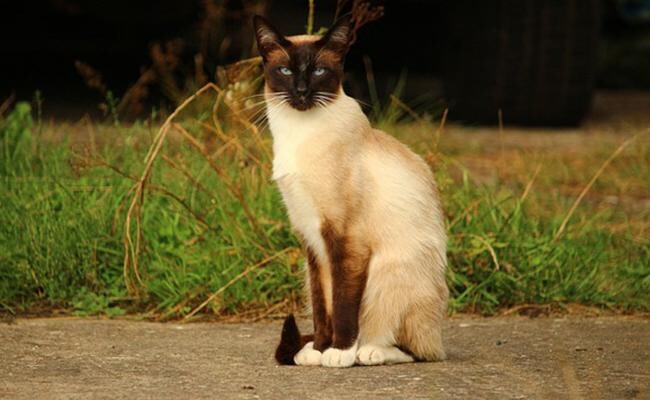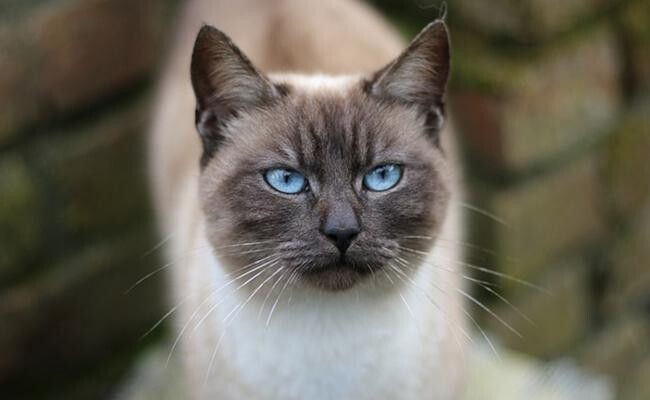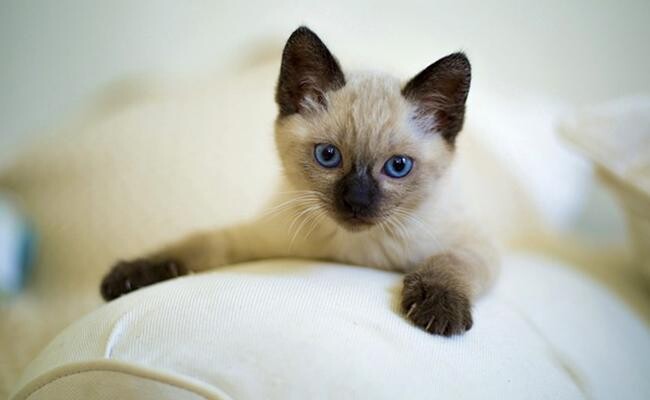Cat Pregnancy Calculator And Timeline
Siamese cats are renowned for their striking appearance, characterized by their beautiful color points, almond-shaped blue eyes, and sleek bodies.
Beyond their looks, Siamese cats are known for their engaging personalities and strong bonds with their human companions. They are sociable, talkative, and love to be involved in their owners’ lives.
With their playful and affectionate nature, Siamese cats bring joy and companionship to any household. Whether it’s their intelligence, curiosity, or vocal nature, Siamese cats make for captivating and cherished feline companions.
Siamese Cat Breed Overview
- Origin: Thailand
- Size: Medium
- Purebred: Yes
- Lifespan: 9 – 15 years
- Height: Male – 12-15 inches, Female – 12-15 inches
- Weight: Males – 9-14 lbs and Females – 6-10 lbs
- Coat Appearance: Glossy, short
- Coat Colors: Cinnamon, Fawn, Cream, Red, Blue, Lilac
- Temperament: Affectionate, pleasing, ready to please, soft-hearted
- Good With Children: Yes (better with supervision)
- Good With Pets: Better with supervision
- Hypoallergenic: No
- Easy To Train: No
- Health Issues: Feline Hyperesthesia Syndrome, Convergent Strabismus and Nystagmus, Wool sucking, Feline Asthma
- Litter Size: 3 to 6 kittens
- Average Price: $250 to $1,200 USD
Siamese Cat Breed Characteristics
- Intelligence Level: Medium
- Grooming: Low
- Shedding: Low
- Suitable For Apartments: High
- Need For Exercise: Moderate
- Good For First Time Owners: High
Siamese Cat History
The cute Siamese is the “auspicious cat” of the King of Thailand. These cats were prized not only for their beauty but also as guard cats.
These cats would be ideally perched on tall pillars around the king’s throne. If anyone raised their voice or threatened the king, these cats would pounce on the individual.
Using their ability and strength to jump from a height, these cats had the capacity to knock the person. If need be, these royal cats would scratch or injure the person who could insult their king.
The authenticity of this legend is quite controversial. The cat watched by the German explorer and naturalist Peter Simon may have been like this breed.
These cats were gifted by the King of Thailand to the British general in Bangkok. The first set of Siamese cats was named Mia and Pho. They were a top breeding pair brought all the way into England in the year 1884.
In the early 1900s, these cats were imported from Thailand, Japan, France, and Britain.
Siamese Cat Appearance
Appearance
These cats represent elegant, long cats. The tail and legs are long, the neck is also long, and the body is too. These cat breeds are muscled but medium-sized.
This is a strange cat. The head appears like a long triangle. They have tall ears.
- Nose – It is straight and long
- Legs – They are slender and long
- Tail – The tail appears long and tapers
- Eyes – The eyes are bright blue and almond-shaped
Coat
The coat appears glossy, and short and lies really close to the body. They have extremely beautiful bodies and charming blue eyes. The contrast between the darker color and the body color is called pointing or color restriction.
The color of the feet, tail, and ears is different from the color of the body. In most cases, the darker color blends into the body.
This cat’s face also exhibits a mask of a deeper point color. It covers the whisker, eyes, and face. The mask grows along with the cat.
The gene which manages the pointed restriction somehow dilutes the cat’s color.
Coat Color
Some of the well-known colors of this cat include –
Siamese Cat Colors
- Cinnamon
- Fawn
- Cream
- Red
- Blue
- Lilac
- Seal
- Chocolate
Siamese Cat Types
There are several types of Siamese cats, which are defined by their coat color and pattern.
Here are some of the most common types of Siamese cats:
- Seal Point Siamese: This is the most common type of Siamese cat and is characterized by a pale, cream-colored body with dark brown or black points on the face, ears, paws, and tail.
- Blue Point Siamese: This type of Siamese cat has a bluish-gray body with darker blue-gray points.
- Chocolate Point Siamese: This type of Siamese cat has a lighter body color that ranges from ivory to light brown, with warm chocolate-colored points.
- Lilac Point Siamese: This type of Siamese cat has a soft, pale gray body with pinkish-gray points.
- Flame Point Siamese: This type of Siamese cat has a pale, cream-colored body with red or orange points.
- Lynx Point Siamese: This type of Siamese cat has a patterned coat with tabby-like stripes on the points.
- Tortie Point Siamese: This type of Siamese cat has a coat with a combination of red or orange and black or brown patches on the points.
Each type of Siamese cat has its own unique beauty and personality traits. However, all Siamese cats are known for their intelligence, playfulness, and affectionate nature.
How Long Does Siamese Cats Live?
The lifespan of Siamese cats typically ranges from 12 to 15 years, but with proper care, they can live into their late teens or even early twenties.
Factors such as genetics, diet, exercise, veterinary care, and living conditions play a role in their lifespan. Providing a balanced diet, regular exercise, and attentive veterinary care can help ensure a long and healthy life for these elegant felines.
However, individual cats may vary, and it’s essential to provide them with a nurturing environment to maximize their lifespan.
Siamese Cat Size
In general, male Siamese cats tend to be slightly larger than female Siamese cats. The average weight range for adult male Siamese cats is typically between 10 to 12 pounds (4.5 to 5.4 kilograms), although some individuals may weigh more or less.
Female Siamese cats, on the other hand, usually have an average weight range of 8 to 10 pounds (3.6 to 4.5 kilograms).
However, it’s important to remember that these are average ranges and individual cats may vary in size based on factors such as genetics, diet, and overall health.
Siamese Cat Mix
Siamese cats can be mixed with a variety of breeds, depending on the individual cat’s lineage.
Here are a few examples of breeds that are commonly mixed with Siamese cats:
- Domestic shorthair or domestic longhair: These are the most common cat breeds found in animal shelters and can easily mix with Siamese cats. Domestic shorthair or domestic longhair cats can have any coat color or pattern and a range of personalities, making them a versatile breed to mix with Siamese cats.
- Oriental shorthair: These cats are closely related to Siamese cats and share many of their characteristics, including their sleek build and vocal nature. An Oriental Shorthair mix may have a slightly different coat color or pattern but will generally have a similar personality to a Siamese.
- Balinese: This breed is a long-haired version of the Siamese and shares many of its traits, including its vocal nature and affectionate personality. A Balinese mix may have a combination of long and short hair, as well as a range of coat colors and patterns.
- Burmese: These cats are also closely related to Siamese cats and share many of their physical and personality traits. A Burmese mix may have a slightly different coat color or pattern but will generally have a similar temperament to a Siamese.
Siamese Cats Care
To ensure the well-being of your Siamese cat, here are some essential care tips:
- Regular Veterinary Check-ups: Schedule routine visits to the veterinarian for vaccinations, health screenings, and preventive care.
- Balanced Diet: Provide a nutritious, age-appropriate diet to maintain a healthy weight and support overall health. Consult your vet for dietary recommendations.
- Grooming: Although Siamese cats have short hair and low grooming needs, regular brushing helps reduce shedding and promotes a healthy coat.
- Litter Box Hygiene: Keep the litter box clean and easily accessible. Provide multiple litter boxes if you have more than one cat.
- Environmental Enrichment: Offer stimulating toys, scratching posts, and vertical spaces to satisfy your Siamese cat’s natural instincts and prevent boredom.
- Play and Exercise: Engage in interactive play sessions to keep your Siamese cat physically and mentally stimulated. They enjoy games that mimic hunting behaviors.
- Dental Care: Maintain good oral hygiene by regularly brushing your cat’s teeth and providing dental treats or toys.
- Vaccinations and Parasite Control: Stay up to date with vaccinations and administer preventive treatments for fleas, ticks, and internal parasites as recommended by your vet.
- Hydration and Fresh Water: Ensure a constant supply of clean, fresh water to keep your Siamese cat hydrated.
Siamese Cat Personality
Siamese cats are known for their unique personalities and distinctive traits.
Here are some of the most common personality traits of Siamese cats:
- Intelligent: Siamese cats are one of the most intelligent cat breeds and are known for their problem-solving abilities, trainability, and ability to learn new tricks.
- Vocal: Siamese cats are very vocal and will often “talk” to their owners, sometimes even following them around the house and meowing to get their attention.
- Affectionate: Siamese cats are very social and love to be around people, often becoming very attached to their owners and following them from room to room.
- Playful: Siamese cats have a playful nature and enjoy playing with toys, games, and other cats.
- Attention-seeking: Siamese cats crave attention and will often demand it from their owners, sometimes even becoming jealous of other pets or family members.
- Active: Siamese cats are very active and love to climb, jump, and explore their environment.
- Loyal: Siamese cats are known for their loyalty and devotion to their owners, often bonding closely with one person in particular.
Siamese Cat Personality Problems
While Siamese cats are known for their intelligence, playfulness, and affectionate nature, like all cat breeds, they can have certain personality traits that may cause problems for some owners.
Here are some common Siamese cat personality issues and ways to address them:
- Vocalization: Siamese cats are known for their chatty nature and can be very vocal, sometimes even to the point of being loud or demanding. This can be a problem for some owners who live in apartments or have neighbors who are sensitive to noise. To address this issue, owners can try training their Siamese cat to use a quieter voice or provide them with plenty of toys and attention to distract them from meowing excessively.
- Separation anxiety: Siamese cats are social cats who thrive on human interaction and can become anxious when left alone for long periods. This can lead to destructive behavior, such as scratching furniture or carpets. To address this issue, owners can try providing their Siamese cat with plenty of toys and playtime before leaving them alone, or consider adopting a second cat to provide them with companionship.
- Possessiveness: Siamese cats can be very possessive of their owners and may become jealous or territorial if they feel their owner’s attention is being diverted elsewhere. This can lead to aggressive behavior, such as biting or scratching. To address this issue, owners can try gradually introducing their Siamese cat to new people or pets and provide them with plenty of attention and reassurance.
Siamese Cat Health Problems
Plenty of health issues, some are hereditary and have been witnessed in individual Siamese cats. These cats have unique wedge-shaped heads. They are susceptible to dental and respiratory problems.
Some common health problems these cats are susceptible include:
1. Glaucoma
Feline glaucoma means a case in which the (aqueous humor) present in the front part of the eye, is finding it hard to drain.
There are two common types of glaucoma
- Primary
- Secondary
Primary glaucoma is breed-related, inherited, and rare. These cats are on the list of predisposed breeds. Secondary glaucoma may develop in both eyes or in one. It is random.
2. Progressive retinal atrophy
Nearly one-third of cats carry a mutated gene. Your pet may not show signs if they carry only one gene. If two carriers produce a kitten, the chance of PRA is more.
Other eye problems associated with these cats include Siamese Nystagamus and feline glaucoma. The latter health issues are considered normal. They present zero health risks.
3. Kidney stones
Nephrolithiasis, or kidney stones, are seen in different breeds such as domestic long-haired, and Persian.
4. Respiratory Issues
Respiratory issues such as feline viral rhinotracheitis and upper respiratory infections are found in young kittens.
By keeping your cat up to date, you can easily reduce the risk of any respiratory problems.
These cats are healthier cat breeds. They can survive close to 15 years. With timely vaccines and check-ups, you can keep your cat healthy.
5. Other health issues include
- Megaesophagus
- Feline Hyperesthesia Syndrome
- Convergent Strabismus and Nystagmus
- Wool sucking
- Feline Asthma
Siamese Cat Training
Training Siamese cats can be a rewarding experience. With patience and positive reinforcement, you can teach them various commands, tricks, and good behavior.
Start with basic commands like sit and stay, and gradually progress to more advanced training. Use treats, praise, and consistency to motivate and reward your Siamese cat.
Remember to keep training sessions short, fun, and engaging. With time and effort, you can shape your Siamese cat’s behavior and strengthen the bond between you both.
Siamese Cat Diet
The Siamese’s jaw and head shape means they are susceptible to swallowing dry cat items whole, instead of chewing them.
Chewing dry food helps in keeping the cat’s teeth clean. Dry food reduces the growth of tartar and plaque.
The most vital piece of information is to choose cat food in shape and size that permits them to chew their food before swallowing it.
Best Cat Food For Siamese Cats
Getting obese is a common problem for all modern cats. Maintaining the weight of your Siamese is the best way to keep her healthy. The CFA’s breed rule for these cats says they should be “refined, lithe, and normal.”
These cats are demanding and vocal. Some cat lovers embrace a rounded look while others prefer the ultra-slim appearance. If you are unsure, contact your vet at the earliest. They should guide you regarding the best cat food for your cat.
Best Dry Cat Food For Siamese
There are plenty of dry food options available on the market. It is no surprise so many cat parents feel confused with the wide variety of choices. Adult cats should consume a well-balanced diet. It should include different levels of Omega-6 and 3 plus 40% fat and 25% protein.
These are specific foods for cats that are important to stop. Some feeds are ideal for senior cats. If these cats do not indulge in physical activity, then a small amount of food is only required.
Best Wet Food For Siamese Cats
Wet food comes in air-tight containers and cans. Leftovers should be stored in the fridge. This type of food should consist of 35% protein. Carbohydrates should be less than 5%. The fat percentage should be between 20% and 25%.
Essential nutrients such as potassium, iron, magnesium, calcium, and phosphorus are necessary. If overused, these foods can cause smelly feces, bad breath, and plaque.
Best Homemade Food For Siamese Cats
The best food for these cats consists of an ideal mix of fresh food, wet food, and dry food. The healthiest food for your cat is pieces of turkey and cooked ham.
Other appropriate foods include hake, cod, salmon, turkey, and chicken. Never serve these foods raw. You have to grill or boil them first. Remove all the bones.
Best Food For Siamese Cat With A Sensitive Stomach
If your Siamese cat has a sensitive stomach, it’s important to choose a cat food that is gentle on its digestive system. Look for cat food that is formulated for cats with sensitive stomachs or for cats with food allergies or intolerances.
Here are some tips for choosing the best food for your Siamese cat with a sensitive stomach:
- Choose a limited-ingredient diet: A limited-ingredient diet contains a smaller number of ingredients and can help reduce the risk of food sensitivities and allergies.
- Look for high-quality protein sources: Cats are obligate carnivores and require a diet high in protein. Look for cat food that contains high-quality protein sources such as chicken, turkey, or fish.
- Avoid common allergens: Some cats may be allergic to common cat food ingredients such as grains, dairy, or beef. Try to avoid these ingredients and look for cat food that is grain-free or contains alternative protein sources.
- Consider wet food: Wet cat food can be easier to digest than dry kibble and may help reduce digestive upset.
- Introduce new food slowly: When switching to new cat food, introduce it gradually over several days to allow your cat’s digestive system to adjust.
Is Siamese Cat Hypoallergenic?
No, Siamese cats are not considered hypoallergenic. Hypoallergenic cats are breeds that produce fewer allergens or dander, which are the primary triggers for allergic reactions in humans. However, all cats produce some level of allergens, including Siamese cats.
While it is true that some individuals with cat allergies may have a milder reaction to Siamese cats compared to other breeds, this can vary from person to person. The allergenic potential of a cat depends on various factors, including an individual’s sensitivity, the specific allergens they are reactive to, and their immune system response.
If you or someone in your household has cat allergies, it’s recommended to spend time with Siamese cats or consult with an allergist to determine your specific sensitivity to Siamese cat allergens before bringing one into your home. Regular grooming, keeping the living environment clean, and minimizing exposure to allergens can also help reduce allergic reactions.
Siamese Cat With Long Hair
Siamese cats with long hair are known as Balinese cats. Balinese cats have a long, silky coats that can be either solid or pointed, like their Siamese counterparts.
Balinese cats are known for their affectionate, social personalities and their intelligence. They are active and playful but also enjoy snuggling with their owners.
Like Siamese cats, Balinese cats are also known for their vocalizations, and they may meow and chatter to communicate with their owners.
Balinese cats require regular grooming to keep their long hair from becoming matted or tangled, and they should be brushed at least once a week to keep their coat healthy and shiny.
If you are looking for a Siamese-like cat with long hair, a Balinese may be a good choice for you.
Siamese Cat Shedding
Siamese cats are known for their minimal shedding compared to many other cat breeds. They have short, fine hair that does not mat easily and lack an undercoat, which contributes to reduced shedding.
While shedding is generally low, Siamese cats may experience a mild increase in shedding during seasonal changes. Regular grooming, including brushing their coat once or twice a week, helps control shedding by removing loose hair and reducing the chances of hairballs.
Providing a balanced diet and addressing any potential health concerns with your veterinarian also contribute to maintaining a healthy coat and minimizing shedding in Siamese cats.
Siamese Cat Grooming
Siamese cats have short, low-maintenance coats that require minimal grooming. Their fine hair does not tangle easily, reducing the need for extensive brushing.
Regular brushing once or twice a week with a soft-bristle brush or grooming mitt helps remove loose hair and keep their coat shiny. Nail trimming every few weeks helps maintain their claws at a proper length.
Additionally, occasional ear cleaning and dental care, such as brushing their teeth, promote overall hygiene. While Siamese cats generally do not require frequent baths, if necessary, use a gentle cat-specific shampoo and ensure thorough rinsing.
Grooming sessions provide an opportunity for bonding and maintaining their well-being.
Interesting Facts
Genetics are not the one and only factor in determining the color of their coat. These cats are excellent chatter-boxes. They have appeared in several movies. Some of the popular ones include That Darn Cat!, The Lady and The Tramp, The Incredible Journey.
White House is also not far for them. Late American President Haye’s wife owned a Siamese named Siam. These cats were treated as royal family members in Thailand. Many cats have crooked tails and crossed eyes. They were believed to be in existence since the 14th century.
Siamese Cat Names
You cannot call all felines as Pink or Betty. Before you choose a name, take a look at some of the names in the list.
This is one of the most popular cats in the entire world. The movie “The Lady and the Tramp” made these cats a household name.
Popular Siamese Cat Names
- Sagwa – Made popular due to the children’s book, Sagwa, the Chinese Siamese Cat
- Yum Yum – The Cat Who … series cat
- Koko – Lilian Jackson Braun’s “ The Cat Who…”
- Am – Lady and the Tramp Cat
- Si – Popular cat from Lady and the Tramp
- Skippy – Siamese cat heroin “Skippy Jones” Books
- DC – “That Darn Cat”
- Tao – The one from “ The Incredible Journey”
Siamese Cat Names Male
Name for Siamese cat male Choosing a name for a Siamese cat can be a fun and exciting task! Of course, these are just a few ideas, and the name you choose for your Siamese cat may depend on their individual personality and characteristics.
Here are a few suggestions for male Siamese cat names:
- Peerapat
- Teera
- Ganny
- Natta
- Tana
- Sara
- Panu
- Pong
- Wut
- Wat
- Simba
- Shadow
- Tiberius
- Leo
- Milo
- Yoshi
- Jasper
- Felix
- Sammy
- Koda
Siamese Cat Names Female
- Praew
- Bow
- Nutcha
- June
- Pim
- Aom
- Arisa
- Fah
- Jane
- Beam
Siamese Cat Price
Before finalizing a pet cat, you should understand your needs and then decide further. A new kitten might want to explore and discover its new surroundings. If left unprotected, many things can harm your cat.
The price of a cat like this can change depending on the breeder’s reputation. We suggest that you learn more about this breed before adopting one.
Their demanding temperament and vocal nature may not be suitable for all cat lovers.
Yep! The charm of this cat will be difficult to resist for many.
Price
The average price can vary between $250 to $1,200 USD.
Siamese Cat Breeders
When looking for a breeder, it is important to ask questions about their breeding practices, their cats’ health, and temperament, and to see any relevant documentation, such as health certificates or pedigree papers.
Reputable breeders will be happy to answer your questions and provide you with the information you need to make an informed decision.
TICA Breeders
TICA makes no warranties or guarantees with regard to the breeding practice of the listed breeders. It is solely at the discretion of the buyer.
- Penelane
Contact name – Michele Lukic
State – Florida
City – Lutz
Website – www.penelane.com
Email – mpkl@aol.com
Phone – 813 -748 – 6894 - Minghou
Contact name – Pat Muise
State – Louisiana
Website – www.minghoucattery.com
Email – minghou1@comcast.net
Phone – 508-395 – 6000 - Abhasiamese
Contact name – Carole Pulkowski
State – Maryland
City – Westminister
Website – www.abha-siamese.com
Email – carole.pulkowski@gmail.com
Phone – 908 – 612 – 3874 - Orisiam
Contact name – Elena Mikirticheva
State – Virginia
City – Richmond
Website – www.oriental-siamese.com
Email – info@orisiam.com
Phone – +1 -886 – 0880 – 1653
FAQ
1. Where Does Siamese Cats Come From?
Siamese cats are an ancient breed of cat that originated in Siam, which is now known as Thailand. They have been documented in Thai literature and art for centuries and were considered sacred by the Thai people.
Siamese cats were first introduced to the Western world in the late 1800s, when they were brought to England and later to the United States.
The original Siamese cats were quite different in appearance from the modern Siamese cats we see today. They had a stockier build and a rounder head shape, with a shorter, thicker coat.
Over time, breeders in the West selectively bred Siamese cats for a more streamlined appearance, with a longer, more slender body and a wedge-shaped head.
Today, Siamese cats are known for their distinctive pointed coloring, with a light-colored body and darker points on their face, ears, paws, and tail.
2. Does Siamese Cat Shed?
Yes, Siamese cats do shed. However, they are considered a low-to-moderate shedding breed compared to other cats.
Siamese cats have short, fine hair that lies close to their body, so they don’t have heavy coats like some long-haired breeds.
Siamese cats shed their fur year-round but may shed more heavily during seasonal changes, such as in the spring and fall. Regular grooming can help control shedding in Siamese cats.
Brushing your cat’s coat regularly with a soft brush or grooming mitt can help remove loose fur and distribute natural oils throughout its coat.
This can help prevent matting and tangling of the fur, which can lead to more shedding.
Additionally, feeding your cat a healthy, balanced diet and providing them with plenty of fresh water can help keep their skin and coat healthy, which can also help reduce shedding.
3. How Long Does Siamese Cat Live?
The average lifespan of a Siamese cat is typically around 12-15 years, although some Siamese cats may live longer if they are in good health and receive proper care.
With proper nutrition, regular exercise, and routine veterinary care, Siamese cats can live long and healthy lives. However, like all cats, Siamese cats may be prone to certain health issues that can affect their lifespan.




